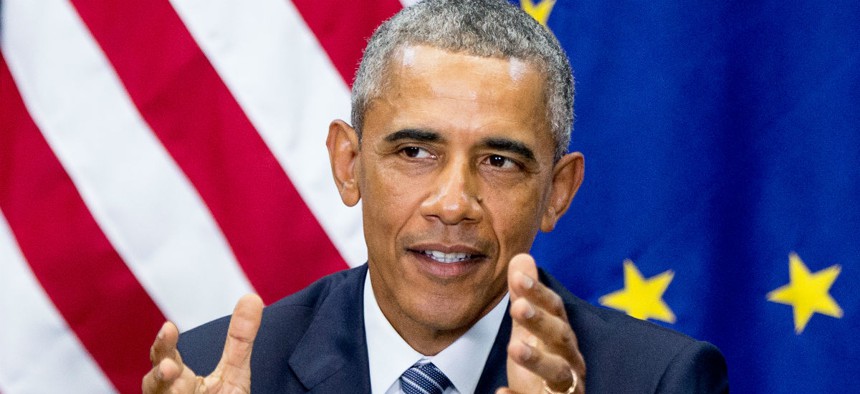
Andrew Harnik/AP
Obama to Announce 'Robust' Senior Exec Reforms This Fall
Changes will come as a result of SES advisory group's findings in the areas of hiring, recruitment, retention and restoring value to public service.
The White House will unveil significant reforms of the Senior Executive Service later this fall, marking one of the Obama administration’s final attempts at improving management in the federal workforce.
The Obama-created White House Advisory Group on Senior Executive Service Reform recently concluded its preliminary work and issued its proposals to the Office of Management and Budget. OMB is currently fine-tuning the recommendations and will roll them out in the coming weeks.
Obama announced the advisory group late last year during a speech to SES members as part of a larger effort to improve the federal government's top career ranks. The group has met three times this year to craft its proposals, in addition to five or six meetings or teleconferences for each “subcommittee” dedicated to specific issues facing the SES.
Some of the changes will be simple tweaks to existing policy, according to members of the 24-person panel, while others will require total overhauls. The minor reforms will take effect immediately upon the rollout, while the larger efforts will require presidential memorandums and significant implementation periods.
“The president encouraged us to be bold and we certainly tried to live up to the challenge,” said Reginald Wells, deputy commissioner for the Office of Human Resources at the Social Security Administration and a member of the group.
Subcommittees focused on four distinct areas -- hiring, recruitment, retention and restoring value to public service -- and the advisory group’s final submission included recommendations for each. The subcommittees largely operated independently, Wells said, and solicited ideas and thoughts about those ideas “from any and all sources.”
The full group meetings, which were coordinated by OMB and the Office of Personnel Management, were organized to go over the subcommittees’ “best findings” and to whittle down the proposals.
Charlie Addington, deputy associate director at the Bureau of Indian Affairs and another panelist, said the process was “really collaborative,” and the support from the administration was “unbelievable.” President Obama himself got involved, attending the first full group meeting in March and making his commitment to the project known throughout.
“I’ve been really impressed with how much he knew about what we were doing,” Addington said. “He knew the details.” Addington added he expects Obama to also be involved in the rollout of the specific reforms this fall.
The group included a range of perspectives, from individuals with both public and private sector experience. While the discussions were “certainly lively,” Wells said, they remained collegial.
“It’s not a shy group,” he said. “People are very passionate on the topic.” He commended the selection of the group’s members, saying it was “an extraordinary gathering of people.”
While the group has submitted its final recommendations, its work is not yet over. Addington noted similar efforts to implement SES reforms have failed as a chasm opened between coming up with ideas and actually instituting them, but said this group is committed to seeing its “robust” ideas through.
The panel will reconvene after the proposals are rolled out to work on implementation efforts.
NEXT STORY: Uninsured Rate Drops Below 10 Percent in 2015







